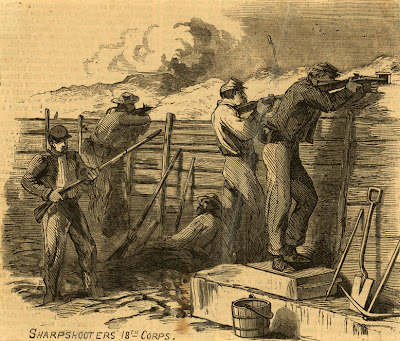 |
| Kurz & Allison. “Battle of Fort Donelson--Capture of Generals S.B. Buckner and his army, February 16th 1862.” lithograph, color. Chicago: 1887. Library of Congress Prints and Photographs Division. http://www.loc.gov/pictures/item/91482118/ (accessed 8/26/2013). |
Battle of Fort Donelson
Richard's depiction of this battle says it all. This image gives a very glorified depiction of the battle and it is interesting because you see a lot of officers standing up in the midst of battle. You see this in other prints made in the day.
 |
“Battle
of Fort Donelson.” Library of Congress
Prints and Photographs Division. http://www.loc.gov/pictures/item/2003664149/ (accessed 8/27/2013).
|
These depictions show the troops standing up in the midst of battle and the officers showing their bravery by standing up and acting as a beacon for their men to follow. That's what they wanted to be seen in the newspapers. The Officers were usually wearing armor under their uniforms. Lincoln had chainmail vest that went from his neck down past his hips, that's why he looked so stiff in appearance. The Yankee officers thought their armor would protect them and so they would lead men into battle standing up in the midst of fire, in a great stand for glory with the assumption that they would be memorialized in a newspaper. They thought they were protected from fire, fortunately they were not because they led men without any such protection into harms way in their attempt to become memorialized in a newspaper. And people want to know why so many people died in the Civil War!
Often I see people re-enacting battles and they stand and they shoot as if they assume that the southerners did not have the range to fire back. Sure there were many battles in the east where they did this type of thing, but I see people doing this at cleaned up battlefields on the Mississippi and I have to wonder at them. They were fighting against fixed fortifications and under sniper and artillery fire. You don't go standing up and making a target of yourself.
Modern battlefields the memorial parks throughout america are cleaned up battlefields. They are not like they were when the war was going on. At Port Hudson they have a small wall about 2 feet high around a gun emplacement, as if they were firing out in the open like that, with the nice cut lawn and the wide vistas to look out on the water. But in the war the place looked like an ant hill. They were dug in like the trenches of World War I. If you exposed any part of your body to fire, you would die.
If you were shot in the body, you were going to die. The caliber of the shot was about 58-65 caliber so if you got hit by that, it would be a huge wound. Many soldiers would say something along the lines of " I've been killed" and they would linger for a day or two and then die. They didn't know about germs or cleanliness. If you were hit in the arm, you probably lost your arm, the same for the leg. Lincoln's chainmail went halfway down his arms.
In these battles against fortifications, you would find the Yankees attacking early in the sieges, trying to gain ground by sending men to their deaths when all they were doing was resupplying the Southerners of guns and ammunition. The southerners would go out at night into the no mans land and pick up the guns and packs of the men who fell in battle and arm themselves with better long range guns.
This is why first hand accounts of the war are so important you can find out what really happened versus the propaganda version found in Harper's Weekly. This is also why Richard would say things like the battle started on a certain day as recorded in history (Harpers Weekly) when in fact it started a lot earlier and he would tell you what really happened.
Three years In the C.S. Army (P.A.C.S) A Diary of a Confederate Soldier by Jerry Pepper and Richard Lauren McClung
Amazon: http://amzn.com/B00FR2MT7I
Amazon: http://amzn.com/B00FR2MT7I

No comments:
Post a Comment